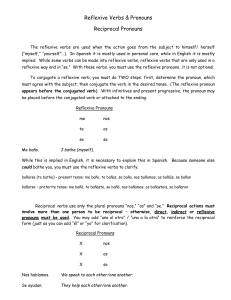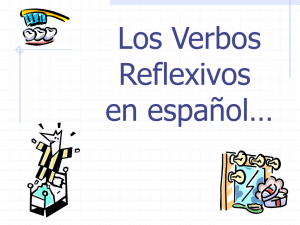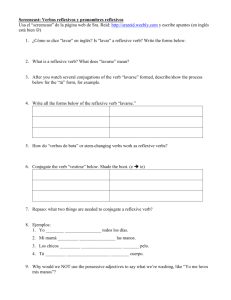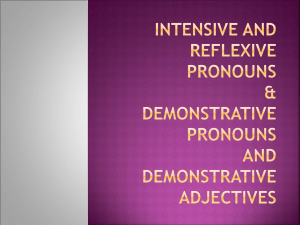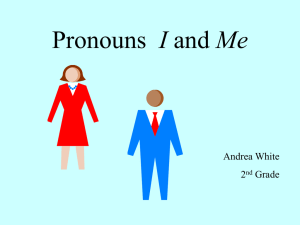Reflexive constructions
advertisement
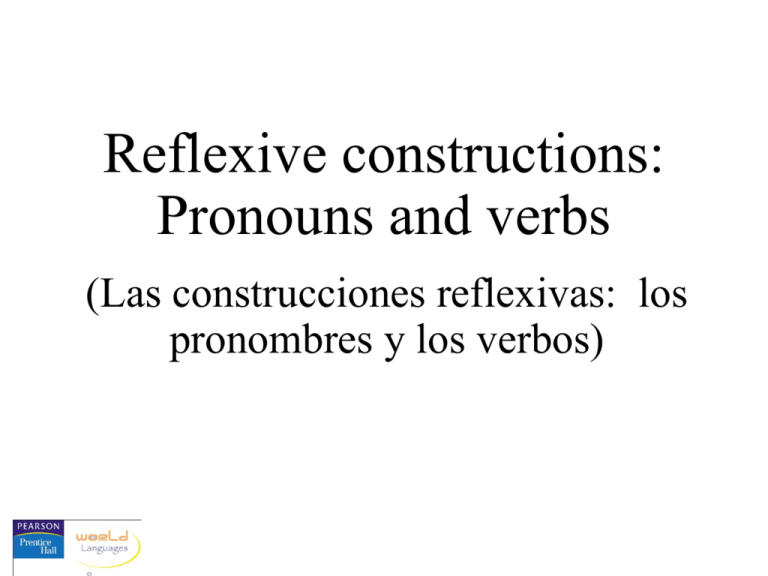
Reflexive constructions: Pronouns and verbs (Las construcciones reflexivas: los pronombres y los verbos) Reflexive constructions in Spanish are generally used to describe actions that people do to, or for, themselves: Notice that we often indicate that a verb is to be used reflexively by attaching se onto the infinitive acostarse (ue) levantarse afeitarse maquillarse bañarse peinarse cepillarse quitarse despertarse (ie) secarse dormirse (ue, u) sentarse (ie) lavarse vestirse (i, i) One useful function of reflexive constructions is to describe daily personal activities. El despertador suena a las 5:00. 10 12 1 2 3 9 8 (Yo) me levanto temprano. 11 7 6 5 4 The subject pronoun, yo, is in parentheses since it is optional in this case; the object pronoun me is used to show who is being gotten up—in this case, the same person as the subject, indicating that I am getting myself up rather than someone else. Whenever the subject and the object of a verb are the same person, the verb is being used reflexively. The reflexive pronouns me te se se nos os se se Note that se serves for both. The only reflexive pronouns that differ in form from direct or indirect object pronouns are third persons singular and plural. Using the verb bañar as an example, the reflexive construction verb paradigm would be as follows in the present tense: Yo me baño. I bathe (myself). Tú te bañas. You bathe (yourself). Él, ella, Ud. se baña. He, she, you (form.) bathe(s) (himself, herself, yourself). Nosotros nos bañamos. We bathe (ourselves). Vosotros os bañáis. You (pl., fam.) bathe (yourselves). Ellos, ellas, Uds. se bañan. They, you (pl., form.) bathe (themselves, yourselves). Notice that English often omits the reflexive pronoun (myself, etc.), whereas it is obligatory in Spanish. Now let’s look at some more daily activities. Clara se seca y se viste después de bañarse. Reflexive pronouns, just like direct and indirect object pronouns, are placed either before the conjugated verb . . . . . . or after and attached to an infinitive or gerund. Isabel se peina. Reflexive action—performed on oneself Isabel could, of course, comb someone else’s hair, in which case a reflexive construction would not be used, since someone other than the subject would be receiving the effect of the verb. Isabel peina a su hermana. Nonreflexive action—performed on someone else Papá se seca el pelo antes de peinarse. Su hija se sienta al tocador y se maquilla. Todos nos acostamos temprano para poder levantarnos a tiempo al día siguiente. Y ahora, ¿cómo nos sentimos? (Now, how do we feel?) Reflexive constructions are often used to describe feelings, moods, and conditions: Some examples are listed below alegrarse (de) to become happy (about) divertirse [ie, i] (con) to have fun (with) enamorarse (de) to fall in love (with) enfermarse (de, con) to become sick (from, with) enojarse (de, con) to get angry (about, at) olvidarse (de) to forget (to or about) Nos alegramos de pasar tiempo con la familia. Me gusta caminar en el parque. A veces los niños se divierten mucho en la bañera. Te vas a enamorar un día de éstos. Me enfermo cuando como muchos dulces. Mis padres se enojan si no me acuesto a tiempo. Nunca nos olvidamos de lavarnos los dientes. The important and versatile verb poner, basically “to put,” means “to put on” (as in clothing) when used reflexively. It also is used reflexively with adjectives to express the idea of “to become.” Pongo mis libros en mi mochila. I put my books in my backpack. En invierno, nos ponemos un abrigo antes de salir. In the winter, we put on an overcoat before going out. Los niños se ponen tristes cuando su padre está fuera. The children are (become) sad when their father is out of town. One another, each other The pronouns nos, os, and se can be used to express reciprocal actions or conditions, that is, what people do to each other or how they feel about one another. Los novios se hablan por teléfono. The lovers talk to one another on the phone. Nos queremos mucho. (We love each other a lot.) Of course, the reciprocal pronouns must be plural by definition, since “one another” refers to more than one person. Note that they coincide in form with the plural reflexive pronouns. FIN
